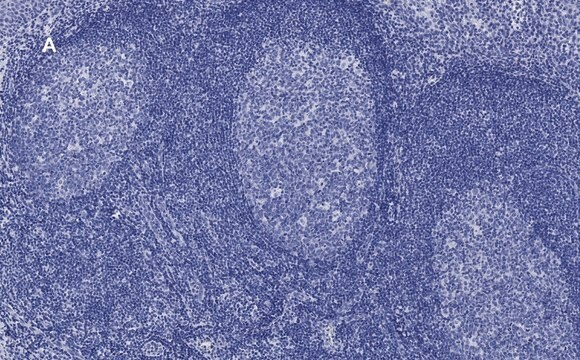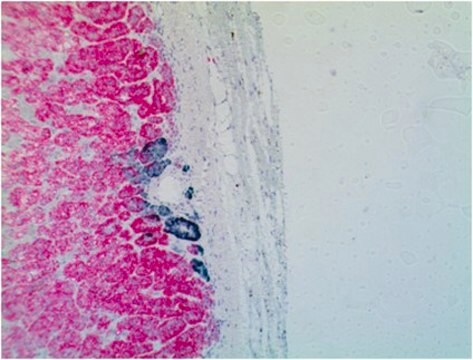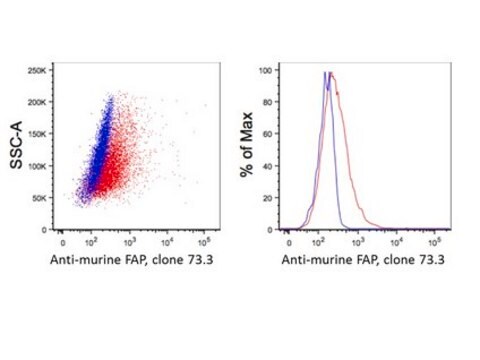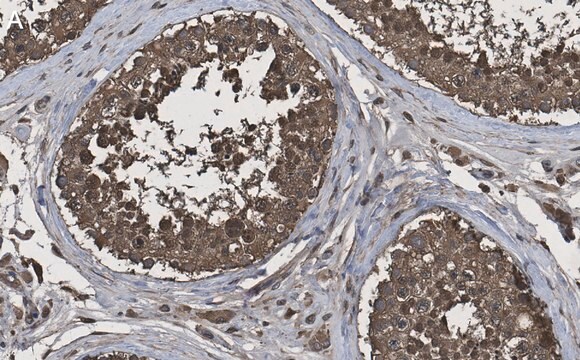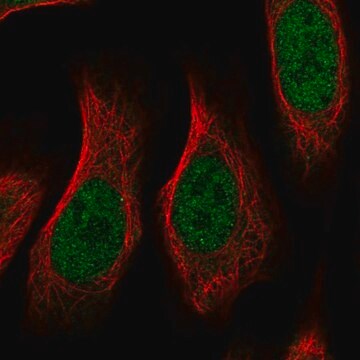おすすめの製品
クローン
polyclonal
品質水準
化学種の反応性
human, mouse, rat
メーカー/製品名
Milli-Mark®
テクニック
immunocytochemistry: suitable
immunofluorescence: suitable
輸送温度
wet ice
詳細
The Milli-Mark ChromaPan Neuronal Marker-ORC is a complete multi-species neuronal antibody blend with an open rabbit channel (ORC) that specifically detects axons, dendrites, and cell bodies with different fluorophores. The Multi-species Primary Antibody blend does not have a rabbit IgG; this allows the researcher to colocalize their own rabbit IgG (against their target protein) to the neuronal cytoarchitecture.
Antibodies to neuronal proteins have become critical tools for identifying neurons and discerning morphological characteristics in culture and complex tissue. Neuron-specific antibodies are convenient precision tools useful in revealing cytoarchitecture, but are limited to the protein target distribution within the neuron, which may differ greatly from nucleus to soma to dendrite and axon. To achieve as complete a morphological staining as possible across all parts of neurons, Millipore has developed a multi-species primary antibody blend that reacts against key somatic, dendritic, and axonal proteins distributed across the neuronal architecture that can then be detected by a single multi-species secondary antibody blend containing discrete fluorophores. As a result, different morphological features (somatic, dendritic, and axonal) are illuminated in different colors: The somato-dendritic cytoarchitecture is detected with DyLight 488 conjugated secondary, and the somato-axonal cytoarchitecture is detected with DyLight 649 conjugated secondary antibody. The primary antibody blend does not contain any rabbit IgGs. The researcher can add a rabbit IgG against their target protein which can be detected with the secondary antibody blend provided by a cyanine 3 conjugated secondary against Rabbit IgG. This pan-neuronal antibody cocktail has been validated in a variety of cell and tissue cultures, giving researchers a convenient and specific qualitative and quantitative tool for studying neuronal morphology.
Antibodies to neuronal proteins have become critical tools for identifying neurons and discerning morphological characteristics in culture and complex tissue. Neuron-specific antibodies are convenient precision tools useful in revealing cytoarchitecture, but are limited to the protein target distribution within the neuron, which may differ greatly from nucleus to soma to dendrite and axon. To achieve as complete a morphological staining as possible across all parts of neurons, Millipore has developed a multi-species primary antibody blend that reacts against key somatic, dendritic, and axonal proteins distributed across the neuronal architecture that can then be detected by a single multi-species secondary antibody blend containing discrete fluorophores. As a result, different morphological features (somatic, dendritic, and axonal) are illuminated in different colors: The somato-dendritic cytoarchitecture is detected with DyLight 488 conjugated secondary, and the somato-axonal cytoarchitecture is detected with DyLight 649 conjugated secondary antibody. The primary antibody blend does not contain any rabbit IgGs. The researcher can add a rabbit IgG against their target protein which can be detected with the secondary antibody blend provided by a cyanine 3 conjugated secondary against Rabbit IgG. This pan-neuronal antibody cocktail has been validated in a variety of cell and tissue cultures, giving researchers a convenient and specific qualitative and quantitative tool for studying neuronal morphology.
特異性
NS340 is specific to axons, dendrites including spines, and the cell body of neurons.
Reactivity with other species has not been determined.
免疫原
Epitope: Whole Neuron Marker
アプリケーション
Research Category
ニューロサイエンス
ニューロサイエンス
Research Sub Category
神経細胞及びグリアマーカー
神経細胞及びグリアマーカー
Immunocytochemistry Protocol
1. Culture neurons as desired. When ready, gently wash with PBS and fix cells with 4% paraformaldehyde in PBS, 5-15 min at room temp (RT).
2. Wash with PBS, 3 x 5min each, at RT and block with 1X blocking buffer for 1 hr at RT.
Note: The blocking buffer provided is supplied as a 5X concentrate. Dilute the concentrate to 1X strength using Milli-Q water. For example, add 20 ml of Milli-Q water to 5 ml of 5X blocking buffer.
3. Incubate cells with ChromaPan Multi-species Primary Antibody blend for 2hr at RT (dilute antibody 1:125 to 1:250 in blocking buffer). Optimal working concentrations must be determined by the end user.
Optional: Rabbit IgG against target protein can also be added to the ChromaPan primary antibody mixture. Optimal working conditions must be determined by the end user. If rabbit IgG is added skip step 4.
4. Wash with PBS, 3 x 5min each, and incubate cells with rabbit IgG against target protein. Optimal working conditions must be determined by the end user.
5. Wash with PBS, 3 x 5min each, and incubate cells with Multi-species Secondary Antibody blend (1:150 in blocking buffer) for 1hr at RT (validated with Chroma Pan to produce minimal background). Optimal working concentrations must be determined by the end user.
Optional: DAPI (1:1000) can also be added to the secondary mixture. If DAPI is added skip step 6.
6. Wash with PBS, 3 x 5min each, and incubate cells with DAPI (1:1000 in blocking buffer) for 5min at RT. Optimal working concentrations must be determined by the end user.
7. Wash with PBS, 3 x 5min each, and cover slip with LIGHT DIAGNOSTICS Mounting Fluid (Catalog No. #5013). View using fluorescent microscope with appropriate filter.
1. Culture neurons as desired. When ready, gently wash with PBS and fix cells with 4% paraformaldehyde in PBS, 5-15 min at room temp (RT).
2. Wash with PBS, 3 x 5min each, at RT and block with 1X blocking buffer for 1 hr at RT.
Note: The blocking buffer provided is supplied as a 5X concentrate. Dilute the concentrate to 1X strength using Milli-Q water. For example, add 20 ml of Milli-Q water to 5 ml of 5X blocking buffer.
3. Incubate cells with ChromaPan Multi-species Primary Antibody blend for 2hr at RT (dilute antibody 1:125 to 1:250 in blocking buffer). Optimal working concentrations must be determined by the end user.
Optional: Rabbit IgG against target protein can also be added to the ChromaPan primary antibody mixture. Optimal working conditions must be determined by the end user. If rabbit IgG is added skip step 4.
4. Wash with PBS, 3 x 5min each, and incubate cells with rabbit IgG against target protein. Optimal working conditions must be determined by the end user.
5. Wash with PBS, 3 x 5min each, and incubate cells with Multi-species Secondary Antibody blend (1:150 in blocking buffer) for 1hr at RT (validated with Chroma Pan to produce minimal background). Optimal working concentrations must be determined by the end user.
Optional: DAPI (1:1000) can also be added to the secondary mixture. If DAPI is added skip step 6.
6. Wash with PBS, 3 x 5min each, and incubate cells with DAPI (1:1000 in blocking buffer) for 5min at RT. Optimal working concentrations must be determined by the end user.
7. Wash with PBS, 3 x 5min each, and cover slip with LIGHT DIAGNOSTICS Mounting Fluid (Catalog No. #5013). View using fluorescent microscope with appropriate filter.
構成
1) 5X Blocking Buffer (Part No. CS204291): 5 ml of an optimized blocking buffer is provided and contains PBS, BSA, serum, trition X-100, and 0.05% azide. Store at 2-8°C.
2) Multi-species Primary Antibody blend (ORC) (Part No. CS204300): 100uL of a proprietary antibody blend with host specific antibodies that reacts against key somatic, nuclear, dendritic and axonal targets. It does not contain rabbit IgG. Presented in PBS containing 0.05% azide. Store at 2-8°C.
3) Multi-species Secondary Antibody blend (Part No. CS204289): 100 µL of a secondary antibody blend containing host specific IgG antibodies against mouse, rabbit, and chicken, conjugated to DyLight 488, cyanine 3, and DyLight 649 dyes respectively. Each individual set has been species absorbed against H, R, B, Gt, Sh, Gp, Eq and/or M, Rb, Ch to minimize background and cross reactivity. Presented in 0.01M Sodium Phosphate, 0.25M NaCl, pH 7.6 with 15 mg/mL BSA, and 0.05% sodium azide. Store at 2-8°C, away from light.
4) DAPI (Part No. CS202687): Vial contains 10 µL of 0.1mg/mL of DAPI. Store at 2-8°C, away from light.
2) Multi-species Primary Antibody blend (ORC) (Part No. CS204300): 100uL of a proprietary antibody blend with host specific antibodies that reacts against key somatic, nuclear, dendritic and axonal targets. It does not contain rabbit IgG. Presented in PBS containing 0.05% azide. Store at 2-8°C.
3) Multi-species Secondary Antibody blend (Part No. CS204289): 100 µL of a secondary antibody blend containing host specific IgG antibodies against mouse, rabbit, and chicken, conjugated to DyLight 488, cyanine 3, and DyLight 649 dyes respectively. Each individual set has been species absorbed against H, R, B, Gt, Sh, Gp, Eq and/or M, Rb, Ch to minimize background and cross reactivity. Presented in 0.01M Sodium Phosphate, 0.25M NaCl, pH 7.6 with 15 mg/mL BSA, and 0.05% sodium azide. Store at 2-8°C, away from light.
4) DAPI (Part No. CS202687): Vial contains 10 µL of 0.1mg/mL of DAPI. Store at 2-8°C, away from light.
品質
Routinely tested on rat E18 cortex primary neurons in Immunocytochemistry 1:150 - 1:100.
物理的形状
Blended polyclonal antibody cocktail in PBS with 0.05% NaN3.
Format: Purified
保管および安定性
Maintain at 2-8°C for up to 6 months from date of receipt.
アナリシスノート
Control
Cortical neurons
Cortical neurons
法的情報
MILLI-MARK is a registered trademark of Merck KGaA, Darmstadt, Germany
免責事項
Unless otherwise stated in our catalog or other company documentation accompanying the product(s), our products are intended for research use only and are not to be used for any other purpose, which includes but is not limited to, unauthorized commercial uses, in vitro diagnostic uses, ex vivo or in vivo therapeutic uses or any type of consumption or application to humans or animals.
シグナルワード
Warning
危険有害性情報
危険有害性の分類
Aquatic Chronic 3 - Eye Irrit. 2
保管分類コード
12 - Non Combustible Liquids
引火点(°F)
Not applicable
引火点(℃)
Not applicable
適用法令
試験研究用途を考慮した関連法令を主に挙げております。化学物質以外については、一部の情報のみ提供しています。 製品を安全かつ合法的に使用することは、使用者の義務です。最新情報により修正される場合があります。WEBの反映には時間を要することがあるため、適宜SDSをご参照ください。
Jan Code
NS340:
試験成績書(COA)
製品のロット番号・バッチ番号を入力して、試験成績書(COA) を検索できます。ロット番号・バッチ番号は、製品ラベルに「Lot」または「Batch」に続いて記載されています。
ライフサイエンス、有機合成、材料科学、クロマトグラフィー、分析など、あらゆる分野の研究に経験のあるメンバーがおります。.
製品に関するお問い合わせはこちら(テクニカルサービス)